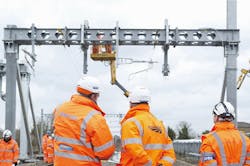Balfour Beatty Completes Milestone on Electrifying 51-Mile Train Corridor Between San Francisco and San Jose
Balfour Beatty has completed its first substantial milestone in the Caltrain Electrification project, which will help transition diesel trains and their infrastructure components to an electrified system in North America.
The project will transform how people travel along the 51-mile Caltrain-owned corridor between San Francisco and San Jose and create a faster, more efficient, and sustainable service for commuters in the Bay Area.
“On a project of this magnitude, ongoing collaboration and an all-hands-on-deck approach was vital, and I commend our team of global experts, various industry partners, and local stakeholders for their partnership in delivering the future of public transportation in the US," said Mark Konchar, Balfour Beatty US Civils President.
The project team installed foundations and 2,569 pre-engineered poles and strung 2,645,050 feet of wire to support the Overhead Contact System (OCS), which powers the fleet of new electric trains. Additionally, 10 traction power facilities - electric power stations used to provide, distribute, and regulate electricity to the OCS and electric trains - were installed between the San Francisco and San Jose corridor.
Construction activities, such as locating underground utilities, testing soil conditions, inspecting signal and communication equipment, and pruning and removing trees, were also performed.
Moreover, Balfour Beatty, Pacific Gas and Electric Company (PG&E), and Caltrain have energized the full corridor through the OCS and traction power facilities and tested the electric trains up to 79 mph.
Balfour Beatty will continue to work with its industry partners and Caltrain to conduct operations and maintenance training, pre-revenue service testing, and complete punch list items along the corridor after substantial completion. The preparations are in progress, and official revenue services will begin in September 2024.
About the Author
EnergyTech Staff
Rod Walton is senior editor for EnergyTech.com. He has spent 17 years covering the energy industry as a newspaper and trade journalist.
Walton formerly was energy writer and business editor at the Tulsa World. Later, he spent six years covering the electricity power sector for Pennwell and Clarion Events. He joined Endeavor and EnergyTech in November 2021.
He can be reached at [email protected].
EnergyTech is focused on the mission critical and large-scale energy users and their sustainability and resiliency goals. These include the commercial and industrial sectors, as well as the military, universities, data centers and microgrids.
Many large-scale energy users such as Fortune 500 companies, and mission-critical users such as military bases, universities, healthcare facilities, public safety and data centers, shifting their energy priorities to reach net-zero carbon goals within the coming decades. These include plans for renewable energy power purchase agreements, but also on-site resiliency projects such as microgrids, combined heat and power, rooftop solar, energy storage, digitalization and building efficiency upgrades.
